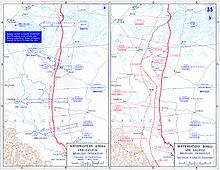This article has an unclear citation style. (May 2024) |
| Brusilov offensive (Fourth Battle of Galicia) | |||||||||
|---|---|---|---|---|---|---|---|---|---|
| Part of the Eastern Front of World War I | |||||||||
 Left: Plan of May. Right: Frontline at the end of Brusilov offensive in September 1916. | |||||||||
| |||||||||
| Belligerents | |||||||||
|
|
| ||||||||
| Commanders and leaders | |||||||||
|
|
| ||||||||
| Strength | |||||||||
|
Initial: 40+ infantry divisions (573,000 men) 15 cavalry divisions (60,000 men) Overall: |
Initial: 39 infantry divisions (450,000 men) 10 cavalry divisions (30,000 men)[2] Overall: 2,500,000 in 54 Austrian divisions and 24 German divisions[1][d] | ||||||||
| Casualties and losses | |||||||||
|
Total: 1,000,000[6][7][8] – 1,440,000[9][10] casualties |
Total: 1,000,000[14] – 1,500,000 casualties[15][1][5][16][17] | ||||||||

The Brusilov offensive (Russian: Брусиловский прорыв Brusilovskiĭ proryv, literally: "Brusilov's breakthrough"), also known as the June advance,[18] or Battle of Galicia-Volhynia,[19] of June to September 1916 was the Russian Empire's greatest feat of arms during World War I, and among the most lethal offensives in world history. The historian Graydon Tunstall called the Brusilov offensive the worst crisis of World War I for Austria-Hungary and the Triple Entente's greatest victory, but it came at a tremendous loss of life.[20] It was arguably the most successful offensive in the entirety of the First World War.[21] The victory contributed to a morale upsurge among the Russian troops, in 1917, Nicholas II planned a general offensive along the entire front in order to end the Central Powers.[22] After the victory, the Petrograd conference was held at which the post-war structure of the world was discussed.[23] Even despite the losses, the Russian armies were still being reinforced with new forces, the number of weapons increased, and new railways were being built.[24] The result of the battle will fully restore Russia's prestige among the allies, which forced them to make serious territorial concessions, such as Anatolia and Constantinople, the French government confirmed the possibility of the Russians themselves to choose which territories to tear away from Germany after the war.[25]
The offensive involved a major Russian attack against the armies of the Central Powers on the Eastern Front. Launched on 4 June 1916, it lasted until late September. It took place in eastern Galicia (present-day northwestern Ukraine), in the Lviv and Volyn Oblasts. The offensive is named after the commander in charge of the Southwestern Front of the Imperial Russian Army, General Aleksei Brusilov. The largest and most lethal offensive of the war, the effects of the Brusilov offensive were far-reaching. It relieved German pressure on French forces at Verdun, and helped to relieve the Austro-Hungarian pressure on the Italians. It inflicted irreparable losses on the Austro-Hungarian Army, and induced Romania to finally enter the war on the side of the Entente. The human and material losses on the Russian side also greatly contributed to the onset of the Russian Revolution the following year.[9] It was the largest battle in World War I according to the total losses and forces of the parties.
- ^ a b c Брусилов 2023, p. 271.
- ^ Брусилов 2023, p. 241.
- ^ Zayonchkovski 2002, p. 563.
- ^ a b Мерников А. Г., Спектор А.А. Всемирная история войн. – Минск., 2005. – стр. 428
- ^ a b Ruhlin 2019, p. 2.
- ^ Gilbert 2023, p. 398.
- ^ Oleynikov 2016, p. 242.
- ^ Кузнецов Б.И Кампания 1916 гг. С.72
- ^ a b Tucker 2002, p. 119.
- ^ Golovin 2014, p. 438.
- ^ Haeften 1936, p. 566.
- ^ Keegan 2000, p. 435.
- ^ Turkey In The First World War: Galicia Archived 20 March 2017 at the Wayback Machine. Turkish losses for September were: unknown on the action of September 2. 7,000 on the actions of September 16/17. 5,000 on the actions of September 30.
- ^ Oleynikov 2016, p. 259.
- ^ Jones, D. R. (2002). "The Imperial Army in World War I, 1914—1917". In F. W. Kagan; R. Higham (eds.). The Military History of Tsarist Russia. New York: Palgrave. pp. 227–248. ISBN 978-0-230-10822-6.
- ^ Miltatuli 2017, p. 154.
- ^ Borisyuk 2024, p. 440.
- ^ Biography of one of the participants (in Russian)
- ^ Borisyuk 2024, p. 163.
- ^ Tunstall 2008, pp. 30–53.
- ^ Millar, James R., ed. (2004). Encyclopedia of Russian History. New York: Macmillan Reference. pp. 932, 1680. ISBN 0-02-865693-8.
- ^ Oldenburg 2022, p. 614.
- ^ Борисюк 2023, p. 96.
- ^ Gilbert 2023, p. 410.
- ^ Utkin 2002, p. 324.
Cite error: There are <ref group=lower-alpha> tags or {{efn}} templates on this page, but the references will not show without a {{reflist|group=lower-alpha}} template or {{notelist}} template (see the help page).